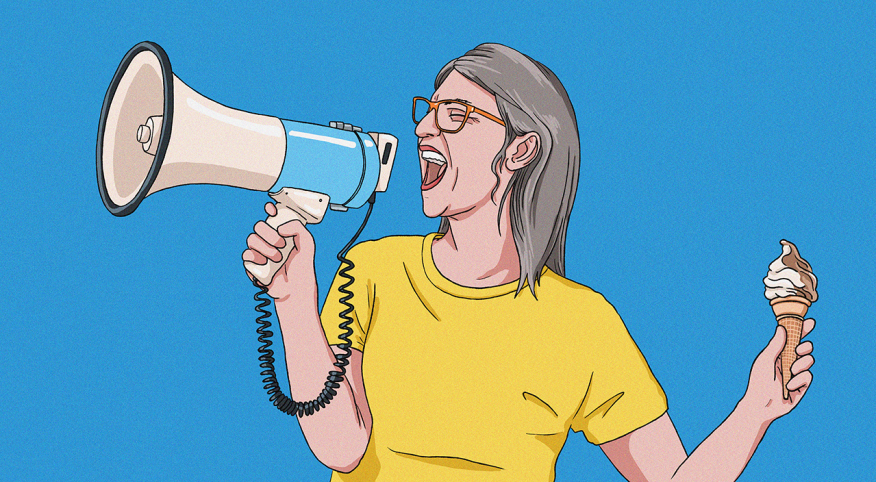Would you like to connect with other older women and make new friends? Then join our amazing private Facebook group, The Ethel Circle, today. You'll love it!
When I was a younger mother, I needed my son Matthew’s medical records to help solve the mystery of his increasingly immature behavior, tanking grades, escalating forgetfulness and clumsiness. To obtain them, I had to visit our HMO and fill out a request form. Then, because electronic medical records were not yet a thing, someone would have to hand-feed papers into a photocopier and mail me the package.
I dragged my feet in making the request because I didn’t want to trouble anyone. I didn’t want to be a burden. Although my heart ached to witness my 10-year-old’s physical and cognitive deterioration, I felt bad for the person stuck with the copying assignment.
I was paralyzed by people-pleasing.
Society expected little girls of my boomer generation to be “sugar and spice and everything nice,” as my mother often sang to me. Since then, we've made progress in breaking that expectation. However, even in the 2020s, research shows, “to be a girl means you cannot assert what you want and need, particularly if it inconveniences others.”
Often, trauma provides the impetus to be nice. I spoke to Lisa Cooper Ellison, Ed.S, a recovering people-pleaser, former mental health counselor and host of the Writing Your Resilience Podcast. According to Cooper Ellison, “A portion of children from violent, chaotic or emotionally unavailable homes grow up to become people-pleasers due to low self-worth and internal beliefs about what it means to be good.”
Dr. Ingrid Clayton, author of the forthcoming book Fawning, Fawning, Fawning: Why the Need to Please Makes Us Lose Ourselves — and How to Find Our Way Back, clarified to me that not all people-pleasing is conscious. "Fawning is instinctual,” she said. “It’s a trauma response meant to diffuse relational harm. The fawner’s intentions aren’t to please or caretake, but rather to find safety in an unsafe world.”
In my case, neither childhood nor relationship trauma played a role in who I became. Conscious or otherwise, I emulated role models at home — my loving Catholic parents who preached and practiced selflessness. But for me, “selfless” became “let people walk all over me.” “Turn the other cheek” morphed into “never stand up for myself.”
When I was a teen during the assertiveness movement of the 1970s, my mother completed her master’s degree in educational psychology. She taught me the difference between passive, assertive and aggressive behaviors. Her textbooks suggested that the only self-respecting choice was being assertive. I became proficient at telling salesclerks "no" and "thank you" and became comfortable hanging up on telemarketers. But I still couldn’t voice my true feelings or opinions to a friend. Pushing my boundaries any further was too scary.
My college sweetheart, later my husband, was and is a nice guy with strong opinions. For example, Mike considers soft-serve ice cream inferior to the scooped-from-the-freezer varieties. Earlier in our 40+ year marriage, when he announced his disdain for the gently frozen dessert, I should have told him, “You don’t know what you’re missing,” as I ordered an extra-large chocolate-vanilla swirl and ate it slowly in front of him. He would have been perfectly fine with it. Instead, I stopped eating soft-serve, even if my husband was nowhere around.
I lacked the skills, the language and the experience to stand up for myself. Why would I assume I’d know how to speak up for my son?
When the pediatrician we had trusted dismissed my concerns about Matthew, repeatedly describing my son’s changes as “common” or “developmentally normal,” I quieted the voice in my head that told me she was wrong. For more than two years, I allowed her medical gaslighting to trample my gut instinct.
Matthew’s psychologist finally nudged me to be the assertive mother I should have been all along. He urged me to request the medical records, encouraged me as I finally demanded referrals and answers. Soon after, an MRI ended the mystery. Matthew had a brain tumor.
I wish I could say I maintained that warrior mom persona, but Matthew’s recovery was long and taxing, and I was too exhausted to nurture my tender new growth. Besides, he received proper care, so I had no need to fight anymore.
Fast-forward almost three decades. At 38, Matthew is healthy and self-sufficient. At 65, I’d written a book chronicling our story, and seeing the truth at my fingertips ripped off my blinders. I couldn’t not change; stagnation would be an insult to Matthew’s suffering. In my hero’s journey, I needed to embody transformation.
I tiptoed before I leapt — asking the grocery store bagger to place the tomatoes on top, telling the hairdresser the water was too hot, asking my physical therapist to wear a mask during the pandemic. These small victories sound childish, but like learning to crawl before you walk, they were necessary steps. Now, being assertive feels less scary. If someone doesn’t like the outspoken me, so what? If Mom is looking down on me, I bet she’s beaming with pride.
For those who have never faced their people-pleasing demons, it’s not too late to start. As we age, we accumulate doctors and must navigate a complicated healthcare system. One day, we may become dependent on others for our care. Now is the time to start exercising your assertive muscles so they’ll flex for you when you need them to advocate for yourself.
If the thought of speaking up makes you cringe, I get it. But don’t let yourself have regrets like I do. Start small and get used to the discomfort of not making others happy. Tune into how great it feels when you are happy.
Before you know it, you’ll be the shoulders-back, chin-high, happily soft-serve slurping woman you always wanted to be. Unless you prefer hard ice cream, in which case, get two scoops with hot fudge topping if you want. Either way, bon appétit!
Are you a people-pleaser? Are you trying to change? Let us know in the comments below.

Michelle Kondrich
Follow Article Topics: Relationships







